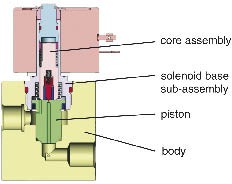Faster Refuelling of Compressed Natural Gas
By Dave Graham, Fluid Control Product Specialist, ASCO NUMATICS


The 303 stainless steel body can withstand high pressures, with the maximum bursting pressure four times the maximum allowable pressure drop.

The 303 stainless steel body can withstand high pressures, with the maximum bursting pressure four times the maximum allowable pressure drop.
It is the declared aim of the EU to increase the market share of alternative motor fuels. Alongside ethanol, global interest is being focused on the use of natural gas for this purpose. Because natural gas has a simple chemical make-up, CH4, it burns cleanly, and emissions of carbon monoxide, sulphur dioxide, soot, and particulates are almost completely eliminated when used as a motor fuel.
Multi bank dispenser (cascade system) gives a filling speed which is comparable to petrol dispensers.
Compressed Natural Gas (CNG) is natural gas compressed into a high-pressure container. The benefits of using CNG as a motor fuel include lower costs, increased performance, and reduced emissions. CNG costs 15 - 40 percent less than petrol or diesel fuel. In addition to the increased performance experienced by CNG vehicles, drivers also get a longer lasting, more reliable vehicle. Emissions reductions are significant at approximately 90 percent lower for CO, 35 – 60 percent lower for NOx, and 50 ~ 75 percent lower for HC. Of course it should be noted that large global reserves of natural gas exist.
No fewer than 5.7 million natural gas vehicles (NGV) are currently in use, and the number is expected to rise to 12.7 million by 2011. Fuel for these vehicles is currently supplied by some 10,000 CNG filling stations throughout the world. By 2011, this number is predicted to increase to about 20,000.
Natural Gas refuelling systems
The principal components of a natural gas filling station are a metered gas supply, a compressor, a storage unit, and a dispenser. Refuelling of a vehicle can actually be accomplished directly by a compressor unit. However, this operation takes several hours, and is usually performed overnight. In order to permit faster refuelling, most filling stations are therefore equipped with single bank or multi bank dispensers.
A single bank dispenser is operated by a single, first level solenoid valve. Its hydraulic system communicates with a single storage unit which stores the gas at high pressure. A multi bank dispenser (cascade buffer storage system) is operated by two or three solenoid valves (first, second and third level). Its hydraulic system communicates with two or three storage units which store gas at different pressures. A three level system is generally divided into three ‘banks’ containing low, medium, and high pressure gas.
During refuelling, the storage banks are automatically connected to the vehicle according to the pressure in the tank. When the vehicle tank pressure is low it is connected to the low-pressure bank. As the pressure in the two tanks equalises, the flow rate decreases. Once it reaches a minimum value, a solenoid valve switches the connection to the medium pressure bank, and then to the high-pressure bank. The order is reversed when the signal comes to refill the banks; first the high pressure bank is filled, then the medium pressure bank, and finally the low pressure bank.
Valve for dispensing Natural Gas
Specially designed solenoid valves are required to control the flow of the Natural Gas to and from the dispenser. ASCO NUMATICS has introduced a compact solenoid valve specifically to cope with the high pressure levels within the multi stage buffer storage system and the rigorous demands of Compressed Natural Gas (CNG) dispensing applications.
The ASCO NUMATICS Series 291 CNG Solenoid Valve is suitable for differential pressures of up to 5000 psi (350 bar) and the flow rate is optimised to attain a high filling speed (Kv value of up to 2.3 m3/h). This compact rugged valve is available in 3/8" (8 mm) and 1/2" (12 mm) sizes and is suitable for use in temperatures of -40 °C to +70 °C and in restricted spaces, especially important as pump sizes continue to be reduced.
The ASCO CNG valve can be supplied with numerous explosion proof solenoid operators making it appropriate for Zone 1/21 - 2/22 applications, according to ATEX 94/9/EC. Enclosures according to NEMA are also available. The valves are available with ISO 228 and SAE threads.
Thanks to a large number of available explosion-proof solenoid operators and threaded connections, the CNG refuelling valve can be used in most countries.
The valve itself functions as an internally piloted valve with a pilot orifice in the piston, which is one of the most important components of the valve. In order to withstand the high pressure, the piston is produced from a single piece of special plastic. This ensures reliable operation and keeps maintenance costs low. Another critical component of the valve is its housing. The 303 stainless steel body can withstand high pressures, with the maximum bursting pressure four times the maximum allowable pressure drop.
ASCO NUMATICS has gained considerable experience in petrol vending applications and has applied this knowledge to the dispensing of "clean" fuels such as Liquefied Petroleum Gas (LPG) and CNG. In both applications the fuels are stored in pressurised tanks and this has led to the development of an innovative three stage delivery system for LNG applications, and the introduction of the new high pressure valve for CNG applications.
ASCO NUMATICS,
Tel: +44 (0)1695 713600

Search related valve / actuator articles: Emerson Automation Fluid Control & Pneumatics UK LtdIssue 7Pneumatic Valves







-web.jpg)





